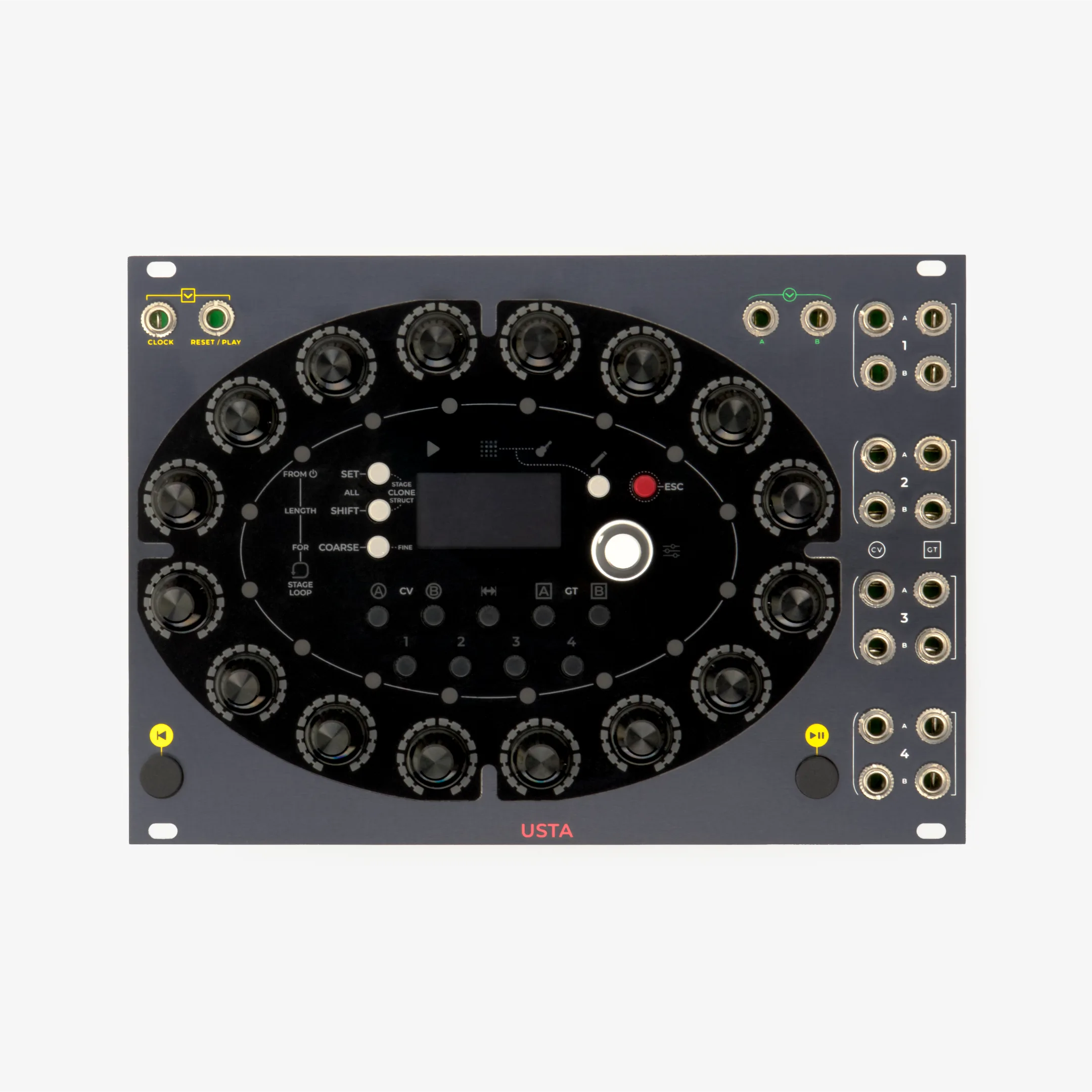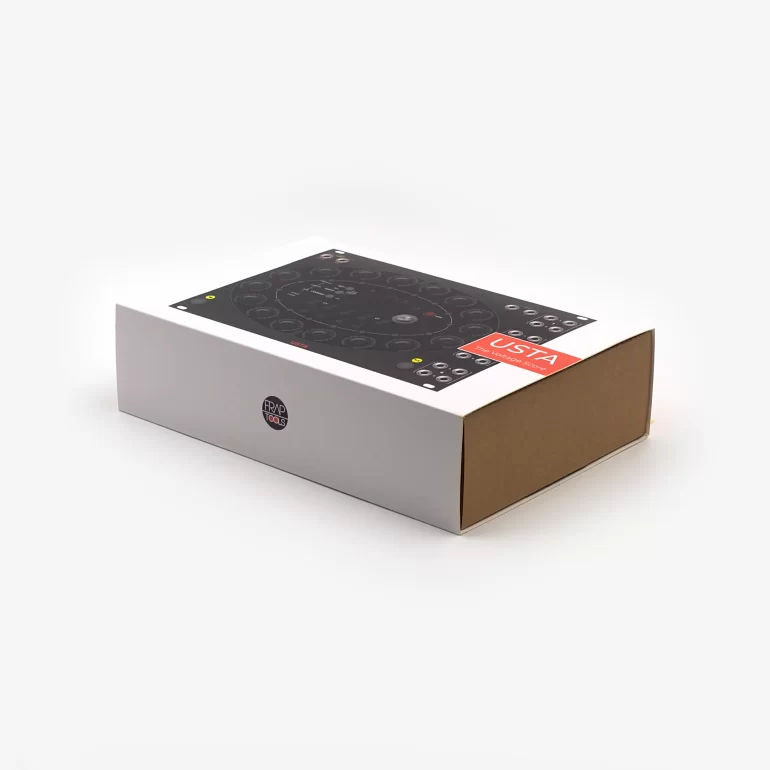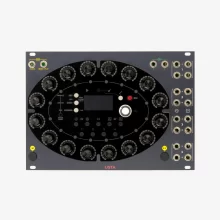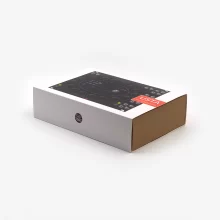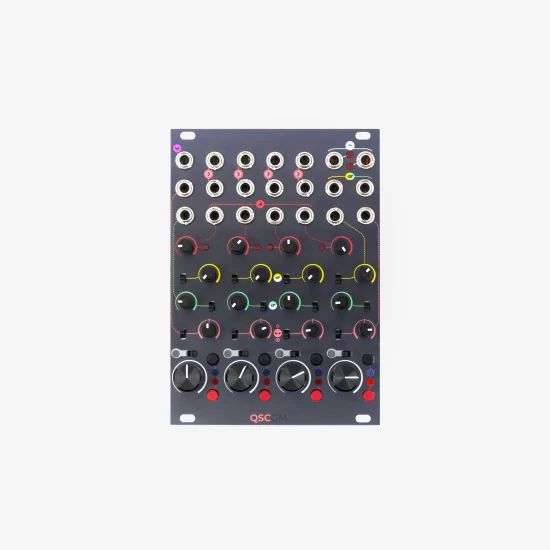Usta
USTA
The Voltage Score
usta / ˈusta / s.f. [probably from an ancient Germanic form, cfr. German Nüster, English nostril] – the trail left by the prey. Idiom., more common: ‘good sense’, ‘wisdom’. Idiom. a usta ‘by heart’. The ‘Usta’ sequencer follows both of those meaning: literally, it gives your patch a trail to follow; more broadly, it offers you a way to approach your composition ‘by heart’, without too much planning.
OR:
650,00 € + VAT
In stock
Description
USTA is a 4×4 tracks sequencer for voltages and gates with variable stage duration, designed to quickly see and edit multiple voltage relationships in real time.
“Variable stage duration” means that every single stage duration can be individually set in relation to the clock, instead of being constrained to a one-to-one ratio (i.e. one stage per every clock impulse).
“4×4 tracks” means that every stage can store and generate up to four separate voltages (two CVs and two gates) and that up to four independent stage sequences can be arranged into as many different tracks.
Its architecture is based on an array of 16 Stages that form a Pattern; 16 patterns form a Track, and four tracks form a Project. Within each track, each stage can provide two gates and two CVs, and a wide set of options is available to define and modify the value of each output (Layers) and the way it is played (Colors).
Every Stage is related to a dedicated stepped encoder for quick and intuitive editing, and all the 16 encoders are arranged in an oval layout with a circular playhead. Every encoder is surrounded by a ring of 16 LEDs and an RGB led, to provide visual feedback of the current setting of that step based on the layer you are working on (like raw CV, quantized CV, length, gate…) and the way it should play depending on the RGB color.
Key Features
- 8×16-bit-resolution CV outputs (each CV output uses a soft selectable range of ±5V or 0/+10V)
- 2×12-bit-resolution CV inputs (-5/+10V range accepted)
- 8×GATE outputs
- 2×GATE inputs
Each track has two programmable gate and CV outputs for a total of four different streams of data. CV and gates share the same Stage duration. You can set the CV to play notes, achieving eight potential melodies at the same time. If you prefer, you can even set them to output unquantized voltages and create complex, arbitrary functions with 1mV resolution.
You can endlessly modify your pattern structure through live pattern recalling, pattern mixing on the fly, and custom loop points. If you prefer having a complex and solid structure, you can use the song mode and define the pattern sequence and repetitions beforehand. The Stage Loop function lets you define a parallel cross-pattern loop section with a flexible starting point, length and duration.
You can independently quantize each track to a given root or scale, and the modulations will still be in tune. If you need a special scale, you can write your own (up to four). If the usual Western 12-tone temperament is not your standard, you can use other octave divisions (15, 19, 22, 24 tones) and create your custom temperament.
Each track can have its own clock division or multiplication and even its own clock speed. You can even run some tracks with an external clock. Such flexibility allows you to achieve polyrhythmic structures and experimental multitempos quickly.
You can individually set the duration of each stage in relation to the track’s clock. This allows you to achieve syncopated melodies and groovy riffs easily. To add even more funk, you can take advantage of the Swing function.
We designed the USTA sequencer so that you could perform without even looking at the display. Sixteen push rotary encoders let you easily define each stage’s value, and three modifier buttons speed up the transposition tasks and the fine and coarse editing. Four single-layer menus allow you to define the core settings independently per track, and the main Project Menu contains the global sequencer settings.
You can compose your song live while USTA is playing, or you can take your time and carefully craft your song note by note through the Composition Mode. In this way, when the sequencer is stopped, you can skim back and forth through the patterns, adjusting every detail. In Composition Mode, you can also plug an external CV controller to insert your note values.
There are plenty of ways to modulate every CV and Gate sequence in a non-destructive way: you can use the internal Variation controls to generate coin tosses and set a pool of potential new values, and you can take advantage of the external CV input to modulate your settings. Whichever route you choose, you can always store the results in a new pattern and use it as a new starting point.
Every CV or Gate value has three different “colors” that change how USTA reads it. You shift a stage color by pushing the sixteen encoders. The blue stage color defines the nominal value: voltage or note for CVs, gate length for gates. The green stage color plays the CVs as a voltage slide from the previous stage and the gates as ratchets: you can obtain a sort of glide and multiple gate repetition by just pushing a button. The red stage color skips the current gate or CV, preventing the DAC from updating.
There are two CV inputs that you can simultaneously address to multiple targets across the four tracks:
- Pitch Shift (modulate a CV in pitch mode minding the scale in use);
- Gate Shift (modulate the gate value);
- Stage Shift (access CVs and Gates of a different stage than the one that is playing);
- Vari Shift (change the variation ranges of all the layers subject to be pseudo-randomized);
- Root Shift (modulate the root note on a track);
- Phase Shift (modulate the phase of a track in relation to its source);
- Pattern Shift (modulate the pattern which is playing in a defined range).
Learn
Learn
Learn
Additional information
| Weight | 0,55 kg |
|---|---|
| Dimensions | 15,6 × 23,6 × 6 cm |
Specs
Size | 36 HP |
Depth | 38 mm |
Current draw | 260 mA @ +12 V 50 mA @ -12 V |
Recommended warmup time | 30 min |
CV input impedance | > 90 KΩ |
CV input resolution | 12 bit |
CV input amplitude steps | ~ 4.15 mV |
CV input voltage span | -5 to 10 V |
Gate input impedance | > 100 KΩ |
Gate input minimum trigger amplitude | > 1.5 V |
Gate input minimum pulse period | 800 µs |
CV output impedance | < 50 Ω |
CV output resolution | 16 bit |
CV output amplitude steps | ~ 0.26 mV |
CV output voltage span | -5 to 10 V |
Gate output impedance | < 50 Ω |
Gate output amplitude | 10 V |
More details on the Manualone.
FAQ
A. Use
Our modules are packed with high-quality components that demand a proper power supply and can get sensibly warm.
That is its normal temperature and we can guarantee their performance.
Yes, you can. With firmware 152, we implemented four ways of interpreting the auxiliary gate input as a Start/Stop/Reset signal.
If you experience strange play/reset behaviors with an external clock, you’re likely running with a small clock ratio, like 1:2, 1:4, and so on.
USTA’s time ratio mechanism works exactly like a digital clock divider or multiplier. If you use small time ratios, you are multiplying the clock. A clock multiplier creates more clocks than it receives, so it needs a steady stream of impulses to calculate the timing.
You have three possible options:
- Use a clock-to-unit ratio of 1:1 whenever you use an external clock (recommended);
- Use lower ratios with the internal clock only;
- Play a sequence once before the “official” playback to allow USTA to multiply the external clock correctly.
Since you can have four different BPM values across the other tracks with USTA, we chose not to include a clock output section.
However, it is still possible to obtain a clock output, even when you have stages of different lengths, and this is one reason we added two gate outputs per track. Here’s how to do it:
- Choose a gate output.
- Set all the gate colors to green (ratcheting mode).
- Set every gate value to match the stage length value.
In this way, you will obtain a continuous stream of gates of precisely one time unit each.
B. Design
We have two main kinds of capacitors.
The first one is necessary to AC-couple the audio signal: they prevent any unwanted DC offset, and they offer protection against wrong connections. For this reason, you can patch nearly every input to every output, and the worst thing that can happen is some pops or some silence.
The second one is power filters to guarantee a cleaner current flow across the case. They might sound a bit over the top, but we must remember that a Eurorack system is not something that comes straight out of the factory. Instead, every Eurorack setup is unique and may change according to the musician’s need. For this reason, we want to add as much protection as we can, both to avoid issues with our modules and to ensure that even the other modules behave correctly. We use a wide mix of capacitors in our modules: ceramic, electrolytic, tantalum, and multilayer. They can be assembled thru-hole or SMD, according to what gives the best balance between result and space. For example, all the electrolytic capacitors are mounted thru-hole because they perform better according to our tests.
However, the capacitors have zero impact on the power draw, on which you can read in this other FAQ.
Power draw should always be related to what a module does.
Generally speaking, there are modules like SAPÈL that undoubtedly consume more than other random generators. However, SAPÈL is a double module, so a fair comparison would be between it and a pair of similar modules. The same can be said for FUMANA, the most power-demanding filter bank. However, it is also the only Eurorack filter bank with 32 analog bandpass filters, half of which have a 48 dB/oct slope. So, also in this case, a fairer comparison would be between FUMANA and TWO other 16-band filter banks, which leads to similar power consumptions.
More in detail, we engineer our modules to be safe to use. To protect both the modules and the rest of the case, we add a proper buffering stage to every input and output: even if a single buffer doesn’t draw that much power, all the ins and outs piled together can significantly impact the final power draw.
C. Shop
Yes! We opened our online store in October 2022. Check out the full catalog!
Our resellers receive our modules exclusively through our distributor, so we do not have access to the individual shops’ orders or stocks.
We restock every module at least once over a year: we focus on a module’s batch at a time, then we move on to the next one, and so on.
If you want an estimated delivery time for a specific module, drop us a line! We’ll be happy to answer you.
